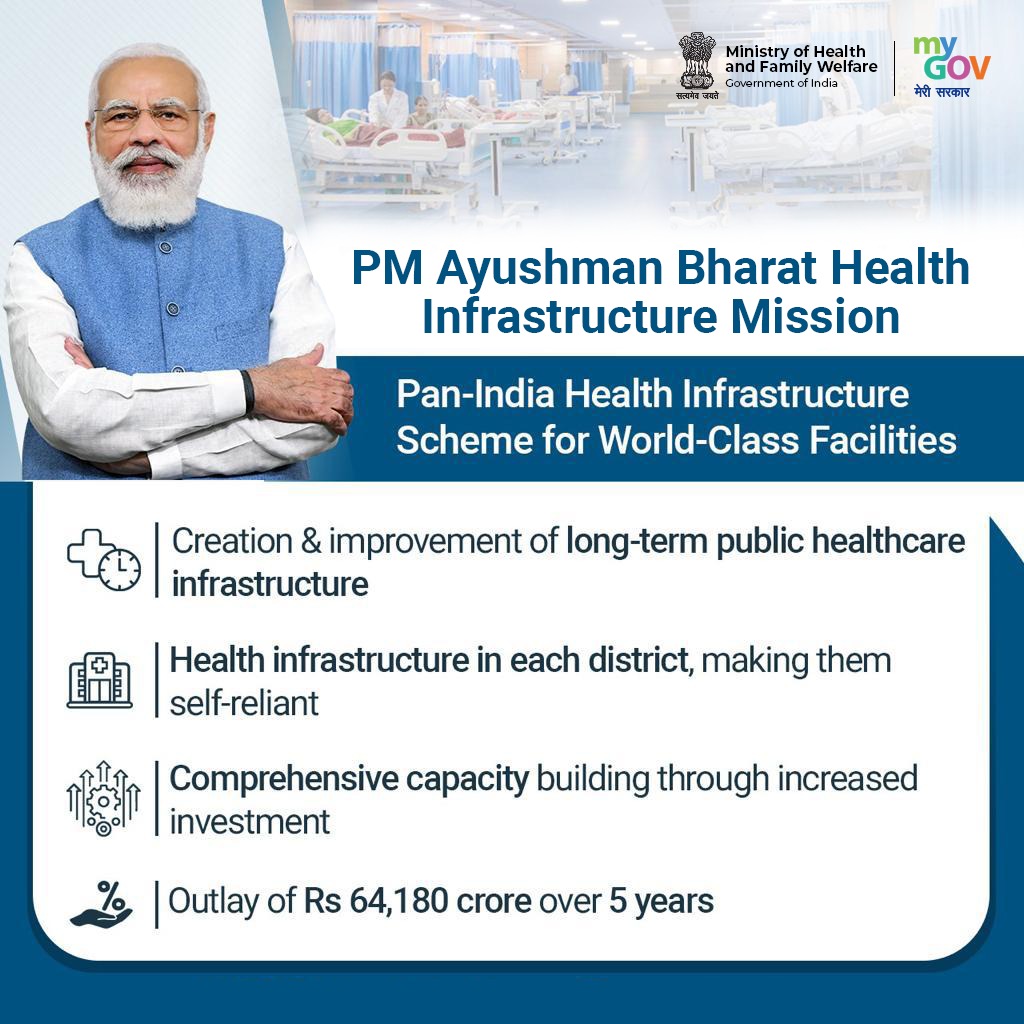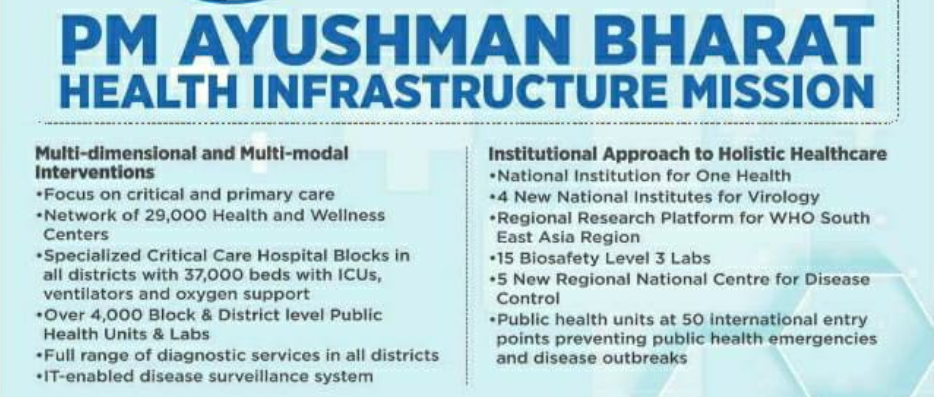ForumIAS announcing GS Foundation Program for UPSC CSE 2025-26 from 19 April. Click Here for more information.
Contents
- 1 Introduction
- 2 About the PM Ayushman Bharat Health Infrastructure Mission
- 3 What are the other initiatives provided under the Health Infrastructure Mission?
- 4 What are the other planned initiatives to improve Indian health care?
- 5 What is the rationale behind the Health Infrastructure Mission?
- 6 What will be the expected benefits of the Health Infrastructure Mission?
- 7 How can India improve the health infrastructure further?
| For 7PM Editorial Archives click HERE → |
Introduction
Recently, the Prime Minister has launched the Pradhan Mantri Ayushman Bharat Health Infrastructure Mission (PM ABHIM) also known as Pradhan Mantri Atmanirbhar Swasth Bharat Yojana (PMASBY). Earlier, the plan was announced in the Budget 2021-22. Now the mission has been formally launched with an outlay of ₹64,180 crores over a period of five years. The scheme is an addition to the National Health Mission and will work towards strengthening public health institutions and governance capacities.
The health infrastructure mission is the largest pan-India Health Infrastructure Scheme that aims to provide a much-needed fillip to India’s capacity to address emergent Public Health issues. This will bring about a paradigm shift in India’s healthcare infrastructure and make it more resilient.
About the PM Ayushman Bharat Health Infrastructure Mission

Objectives of the PMASBY: The mission’s objective is to “fill critical gaps in public health infrastructure, especially in critical care facilities and primary care, in both the urban and rural areas”. The PM ABHIM also aims to establish an IT-enabled disease surveillance system through a network of surveillance laboratories at block, district, regional and national levels.
The scheme also aims to detect, investigate, prevent, and combat public health emergencies and disease outbreaks.
Key components of the Scheme

The health infrastructure mission has three critical components. These are:
Comprehensive surveillance of infectious diseases: Under this, health and wellness centres will be opened in villages and cities, where there will be facilities for the early detection of diseases. Facilities such as free medical consultation, tests, and medicine will be available at these centres.
Comprehensive diagnostics and treatment facilities: This will involve the development of testing infrastructure. All 730 districts of the country will get integrated public health labs and 3,000 blocks will get public health units. Apart from that, five centres for disease control, 20 metropolitan units, and 15 BSL labs will strengthen this network.
Comprehensive pandemic research: The existing 80 viral diagnostic and research labs will be strengthened, four new National Institutes of Virology(NIVs) and a National Institute for One Health are being established.
Laboratory capacity under the National Centre for Disease Control, the Indian Council of Medical Research and national research institutions will be strengthened. Fifteen bio-safety level III labs will augment the capacity for infectious disease control and bio-security.
| Read more: Country’s first ‘One Health’ consortium launched by D/o Biotechnology, Post COVID 19 |
What are the other initiatives provided under the Health Infrastructure Mission?
Free diagnostics at district level: Under the PMASBY, 134 different types of tests will be done for free at the district level, which will not only save costs but also reduce unnecessary inconvenience for poor people.
Mobile hospitals: For the first time in Asia, two container-based hospitals with comprehensive medical facilities will be kept ready at all times under the PMASBY. One mobile unit will have 22 containers with 100 beds each.
These mobile hospitals will be stationed in New Delhi and Chennai. These hospitals can be swiftly mobilized by rail or air to respond to any calamity or disaster in the country.
Strengthening NCDC: The existing National Centre for Disease Control (NCDC), which has a mandate to cover disease outbreaks, would be strengthened under PMASBY by adding three new divisions.
These would be the climate change division, occupational health division, disaster management division. Five regional branches of NCDC — one each in the north, south, east, west and central regions — would be established. The overall epidemiological intelligence services would also be upgraded.
What are the other planned initiatives to improve Indian health care?
Saturation approach: The government is also working with a ‘Saturation Approach’ with the Block, District, State and National levels seamlessly connected for affordable and quality healthcare.
Increase in health and wellness centres: Almost 150,000 health and wellness centres offering a full range of services, including tele-consultation, will be set up both across rural and urban areas by 2022. Each such centre will cover five villages in rural India.
| Read more: One billion Covid Vaccines and beyond – Explained, pointwise |
What is the rationale behind the Health Infrastructure Mission?
Improve India’s health infrastructure on multiple fronts: According to the 2020 Index report by Oxfam India, India’s health budget is the fourth lowest in the world (expenditure on health as % of the total budget). Neighbouring countries Pakistan, Nepal and Bangladesh spent more on health than India (as % of the budget on health). According to the World Health Organization (WHO), India ranks 184 out of 191 countries in health spending.
Hence, this scheme has been launched to improve an entire ecosystem of services from treatment to critical research.
Lack of Primary Healthcare (PHCs) Services: The existing public primary health care model in the country is limited in scope. Only services related to pregnancy care, limited childcare and certain services related to national health programmes are provided in most PHCs. So, the Health Infrastructure Mission was launched to strengthen the existing public primary health care infrastructure with a host of services.
Address the inability of the private sector: COVID-19 overburdened the country’s health system and services. The early months of the outbreak were particularly burdensome for the States with weaker health systems.
The inability of the private sector to share the burden drove the point home that healthcare services cannot be left to independent forces. Further, massive hospital bills have caused untold distress even among the middle class.
Apart from that, there is also a large-scale misuse of medicine in the private sector during the pandemic. For instance, The ‘Remdesivir panic’ was significantly linked with major overuse of this medicine by unregulated private hospitals, despite the drug lacking efficacy to reduce COVID-19 mortality.
So, the government introduced the health infrastructure mission to strengthen the public health sector.
Fulfilling the recommendation of the Finance Commission: The Fifteenth Finance Commission recommended strengthening of urban and rural primary care, stronger surveillance systems and laboratory capacity as well as the creation of critical care capacity at different levels of the health system. The ABHIM aims to fulfil these recommendations.
What will be the expected benefits of the Health Infrastructure Mission?
Make India’s health system future-ready: PM ABHIM aims to produce robust outcomes in Public Health, leapfrogging India to one of the most advanced countries in the world in terms of management of Public Health outbreaks.
Various initiatives under PMASBY such as the National Platform for One Health, regional NIVs, etc, will further strengthen India’s capacity to detect & diagnose new infections at a faster pace. Points of entry will be strengthened to ring-fence India against the import of new infectious diseases and pathogens.
Make the Ayushman Bharat initiative as an umbrella initiative: The Ayushman Bharat- Health & Wellness Centres was launched in April 2018 followed by Ayushman Bharat-PMJAY in September 2018. The Ayushman Bharat Digital Mission was launched earlier this year.
The new scheme’s focus on Health Infrastructure makes the Ayushman Bharat initiative as an umbrella initiative. Together they provide the following
– Provide affordable, quality and accessible healthcare to all people and reduce out-of-pocket expenditures.
– Provide universal access to basic diagnostic and treatment services, and will take healthcare closer to the communities in both rural and urban areas.
– Covering almost all the domains of health.
| Read more: Ayushman Bharat Digital Health Mission – Explained, pointwise |
Make India self-sufficient: Setting up of the national, regional, state, district and block level laboratories backed by a robust I.T. ecosystem will lead to self-reliance on detection, prevention and containment of disease outbreaks.
Ensure non-disruption of other services during events like the pandemic: Many non-COVID-19 patients were denied treatment during the pandemic, as hospitals were crowded. Critical care hospital blocks will enable care for those with serious infectious diseases without disrupting other services. In non-pandemic situations, this capacity will be utilised for providing critical care for other disease conditions.
| Read more: Health Ministry Releases “National Policy for Rare Diseases 2021” |
How can India improve the health infrastructure further?
Encourage participation of states: Like other centrally-sponsored schemes, the Centre will bear 60% of the cost, while the States will have to shell out the remaining. So, the Central government has to encourage States’ active participation for the success of the scheme.
Increase health budget: Parliamentary Standing Committee recommended that for reaching National Health Policy targets, the Government must allocate ₹1.6-lakh crore for public health during the current year. This is double the amount of the present central health Budget.
So, the centre has to increase the public funding on health to at least 2.5% of GDP as envisaged in the National Health Policy, 2017 to improve the health infrastructure and achieve national health policy targets.
Need more health professionals: According to government data, India has 1.4 beds per 1,000 people, 1 doctor per 1,445 people, and 1.7 nurses per 1,000 people. Over 30,000 MBBS seats and 24,000 postgraduate seats in medicine have been added since 2014. But, the creation of infrastructure has to be matched with additional human resources, so the government has to improve the required manpower.
Check private malpractices: The Clinical Establishments (Registration and Regulation) Act (CEA) was passed in 2010 to provide for registration and regulation of all clinical establishments in the country. The Act is presently applicable to only 11 States across India. The central government is yet to take the necessary steps to promote the implementation of the CEA.
This resulted in large-scale misuse from private sector hospitals, for example, massive hospital bills during the pandemic. So, the government has to ensure proper implementation of the Act to check private sector malpractices.
In conclusion, initiatives like Swachh Bharat Abhiyan, Fit India, Khelo India and Yoga focussed on preventive health. Along with other Ayushman Bharat initiatives, the Health Infrastructure Mission (PMASBY) is another step towards comprehensive healthcare in India.




